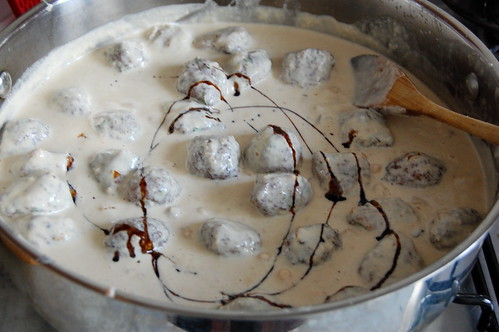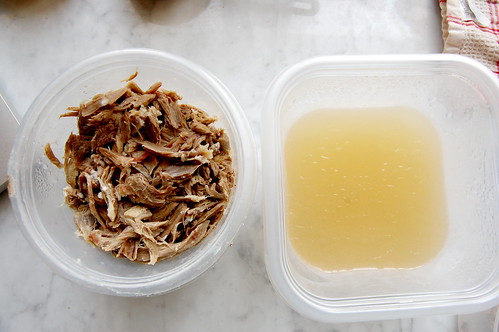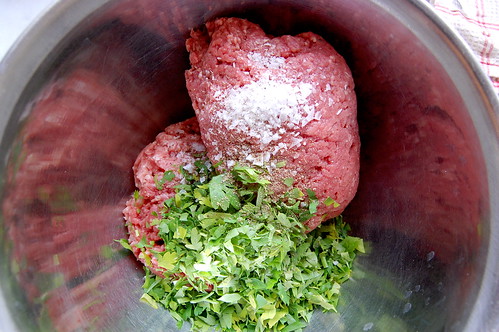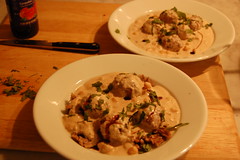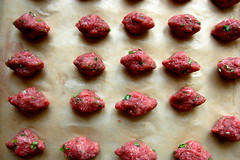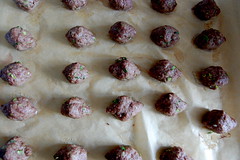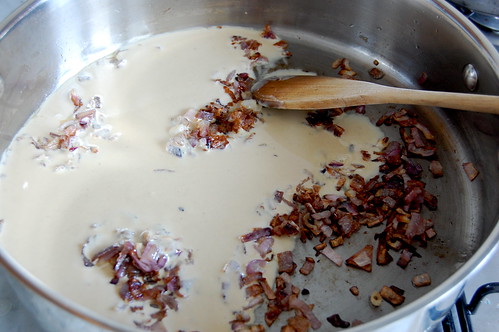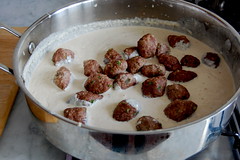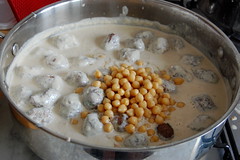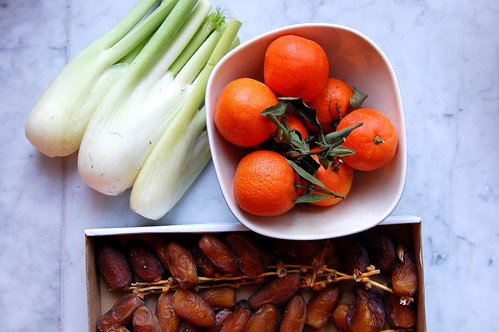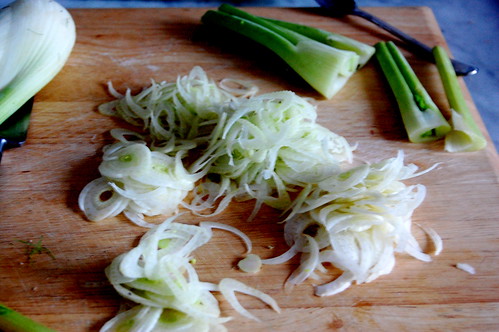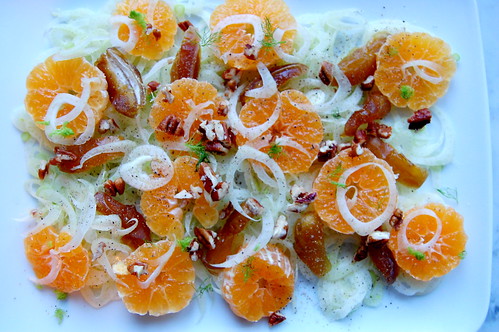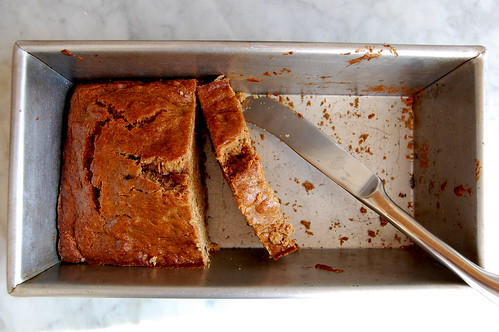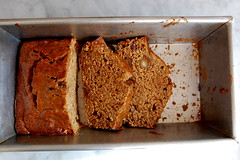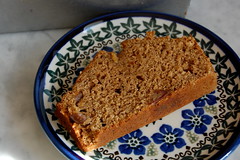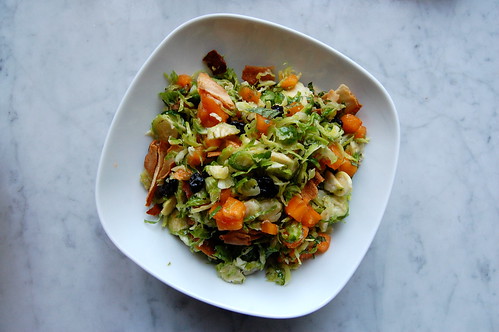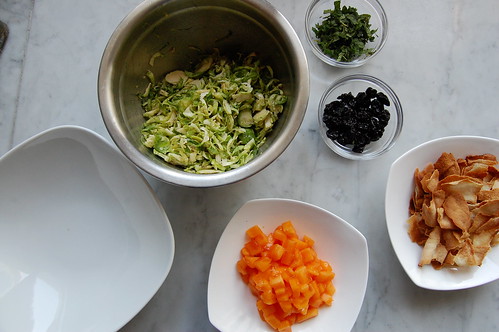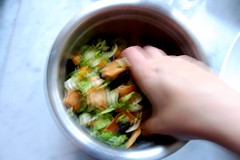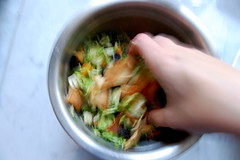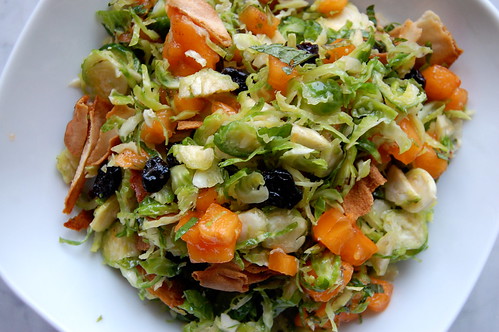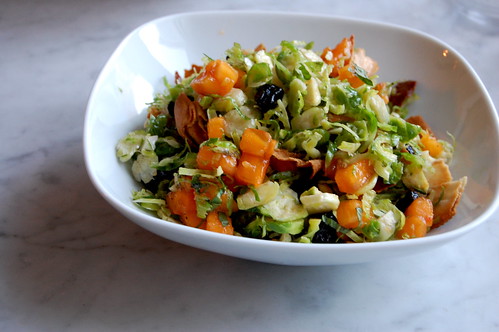
Did you know that "Israeli couscous" is actually called berkoukes? Do you know the difference between shakshouka and chikhchouka? Did you know that there's a type of bulgur made out of barley wheat (maybe it will be the next health food trend?!) Or, did you know there's a North African green chile paste that's not harissa (and not called green harissa!)?
I've started a list of Algerian cooking vocabulary, a space where I can add things that I learn as we go along. I thought you readers might enjoy it as well. If you want to chime in that's welcome too. I've kept the focus on Algeria, so you won't see things like Moroccan bastilla or Tunisisan lablabi, although there is always plenty of overlap.
Amekfoul (timkefelt) -- Couscous with steamed vegetables, traditionally from Kabyle.
Baghir (crepes mille trous, korssa) -- Yeasted semolina pancakes that are cooked only on one side. Served with honey and butter.
Berkoukes -- known in the West as "Israeli couscous," large pearls of semolina couscous. It is actually from North Africa, where it is actually called berkoukes. Often used in soup called aiche.
Brik/bourek -- basically North African spring rolls. Usually meat, herbs, and an egg wrapped in a pastry leaf and fried in oil.
Chikhchouka (charchoura biskria, chakchouka) -- Not the same as shakshouka! A stew served over torn msemmens bread. The stew is usually chicken-based. Though the torn msemmens bread is most common, some people serve the stew over small pasta squares which are also called (guess what!) chakchouka.
Cherhcem -- traditionally served for Algerian Berber New Year (Yannayer). It is a simple mix of cooked wheat berries, dried fava beans, chickpeas, and lentils, seasoned with olive oil, cumin, and harissa.
Chermoula -- a cilantro-based sauce usually for cooking fish.
Chtitha Djej -- Basically a chicken stew, often involving chickpeas, ras el hanout spices, and onions. Some are tomato-based, while other don't have tomato (sauce blanche).
Chorba Frik (Jari, Frik Soup) -- Frik is actually a type of green bulgur (blé
concassé) found in North Africa (it is not the same as the Levantine freekia). It is traditionally used in a soup with tomatoes and meat.
Couscous -- You probably know what couscous is, tiny grains of semolina pasta. It is important to emphasize that there are many kinds of couscous -- wheat flour couscous, barley couscous, etc. It is always laboriously steamed in the top of a couscousier.
Dersa sauce -- a mildly spicy tomato-based sauce. Often served with fried sardines. It can also be used as a sauce in which to cook vegetables and legumes (cauliflower in dersa, white beans in dersa).
Dwida (douida) -- A stew served over short steamed vermicelli noodles and topped with hard boiled eggs. The stew can be chicken, lamb, or beef, with onions and chickpeas.
Feuilles de brik (malsouka, waraqa) -- The thin pastry used to make brik.
Garantita (karantita) -- A baked sort of souffle made from chickpea flour, eggs, and milk. Often put between bread with harissa and mayonnaise as a sandwich.
Gnawiya -- an okra, tomato, and meat stew.
Gueddid (keddid) -- a kind of dried beef similar to jerky. Read more here.
Hamis (hmis, chlita, meshwiya, felfel) -- a spicy green chile paste. Sometimes mixed with tomatoes and/or olives to be served as a dip. The chiles are often grilled or roasted in the oven. (Hmis is usually very spicy, while felfel and meshwiya are milder.)
Harira -- the soup traditionally served to break the Ramadan fast. It usually has meat, spices, legumes, and a tomato base.
Harissa -- an oil-based spicy red chile paste. Can be made with fresh or dried chiles and involve spices such as caraway, cumin, paprika, or garlic.
Hrouss -- A condiment from Southern Tunisia using dried onions, dried chiles, coriander, caraway, and dried rose buds.
Kesra matloua -- a raised puffy flat bread made of semolina or wheat flour and cooked in a pan in the oven. Photo here.
Kesra rakhis (aghrum, galette, khobz ftir) -- An unleavened flat bread of semolina flour cooked in a pan. Delicious.
Khobz dar -- literally, house bread. A puffy round loaf of bread made at home, usually with a thick egg glaze over the top and very soft inside. Nigella seeds are often included. Recipe here.
Mardoud (t'am laghlid) -- another kind of large couscous, bigger than regular couscous but a tiny bit smaller than berkoukes. It is a specialty of Southern Algeria.
Mhajeb (mahjoub, crepes farcie) -- a very very thin semolina/flour dough (the same dough used for msemens bread), that is cooked on a well oiled griddle and filled with tomatoes and onions. They can be spicy or slightly sweet. Video here.
Mhamsa -- a tomato-based thick soup with meat and large-size couscous. Berkoukes are often used, although sometimes shops sell large sized couscous named mhamsa.
Merguez -- a fatty beef sausage with lots of garlic and red pepper.
Mesfouf -- Couscous with peas and fava beans. Or couscous with dates, nuts, and butter. Recipe here.
Mermez -- Mermez refers to both a type of bulgur made from barley and the meat stew that is served with the bulgur. Mermez (orge concassée) looks like dark brown bulgur and is often served for Eid el Adha. In Tunisia mermez usually refers to a tomato-based stew of beef or lamb.
Mrouzia -- a lamb stew with honey, spices, and raisins.
Msemmen bread (m'semmens, mtawi, ma'arak, crepe feuiletee) -- a very very thin layered semolina bread cooke don a griddle. They layers are coated with oil, hence the name which means "fatty." Similar to Moroccan rghayif.
Mtouem (mtewem) -- a dish of garlicky meatballs.
Preserved lemons (citron confit) -- whole lemons preserved in salt brine.
Sfyria -- a simple stew (usually of lamb shoulder) with fritters. The fritter dough is made of stale bread soaked in milk, cheese, and eggs, formed into balls, and deep fried. The fried cheese balls are served on top of the stew. Some people put the meat in the fritters and serve them with chickpeas.
R'fissa -- A Moroccan dish similar to chakchouka in Algeria. A chicken stew with onions and spices (ras el hanout, ginger, saffron, fenugreek) that is served over torn msemmens bread. (note, it is different than an Algerian dessert call rfis)
Reshta (rechta) -- A stew of chicken or meat, chickpeas and turnips served over long thin steamed noodles. (See a picture of the noodles here.)
Shakshouka -- a mix of grilled pepper and tomatoes (like chlita, felfel) with eggs mixed in while cooking and served warm. In Algeria the eggs are usually scrambled into the sauce, though the eggs can also be poached.
Tabil -- a Tunisian spice mix, tabil is also used in Tunisia for coriander. The spice mix can include coriander, caraway, garlic, chili.
Tajine -- a stew traditionally made in a connical clay pot.
Tagine h'lou -- literally meaning sweet tagine, a tagine of lamb with dried fruits and honey.
Tagine kefta -- A tagine of meatballs in tomato sauce. Usually eggs are cracked into the sauce just before serving, aloowing the eggs to poach.
Tagine khokh -- Literally meaning "peach tagine," it is a play on words as the peaches are actually deep fried balls of mashed potato and ground beef. The fried potato balls are served with the stew. Recipe here.
Tamina -- a paste made of semolina, butter, and honey. It is often decorated with cinnamon and almonds. Served for dessert particularly on Mawlid al-Nabi.
Tlitli (langues d'oiseau) -- A stew served over small steamed pasta (similar in appearance to orzo) and topped with hard boiled eggs. The stew is most often chicken, chickpeas, and onions. Recipe here.
Trida (mkartfa) -- A stew of chicken (or lamb shoulder or meatballs) with onion, cinnamon, chickpeas. The stew is served over the trida pasta, small steamed pasta squares, and it is always garnished with hard boiled eggs.

